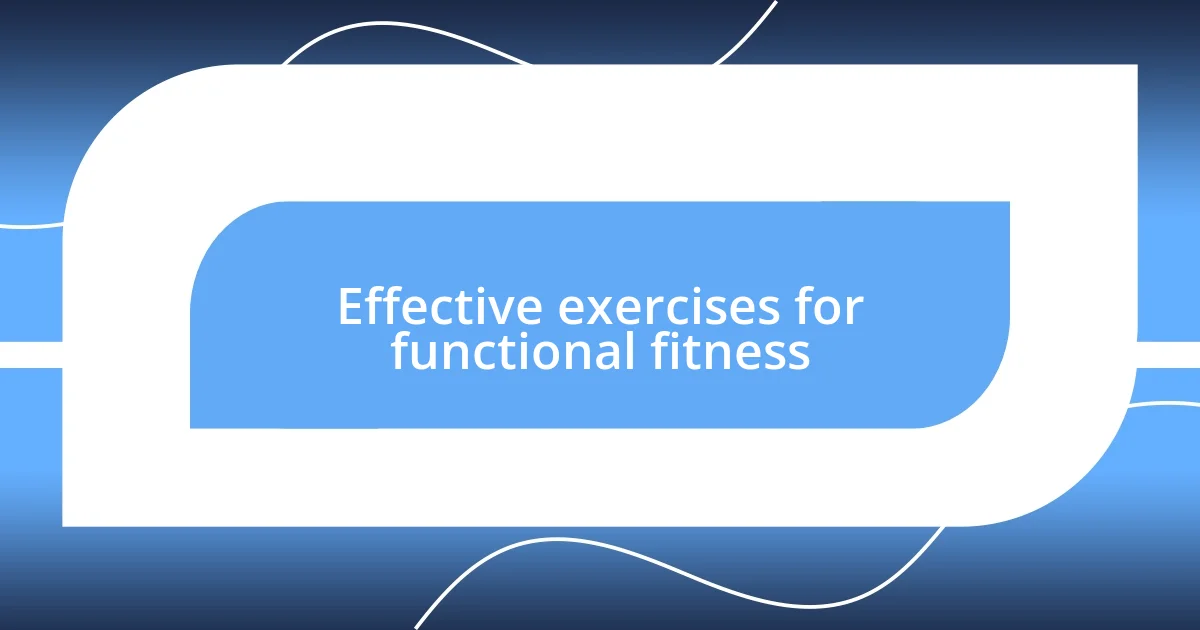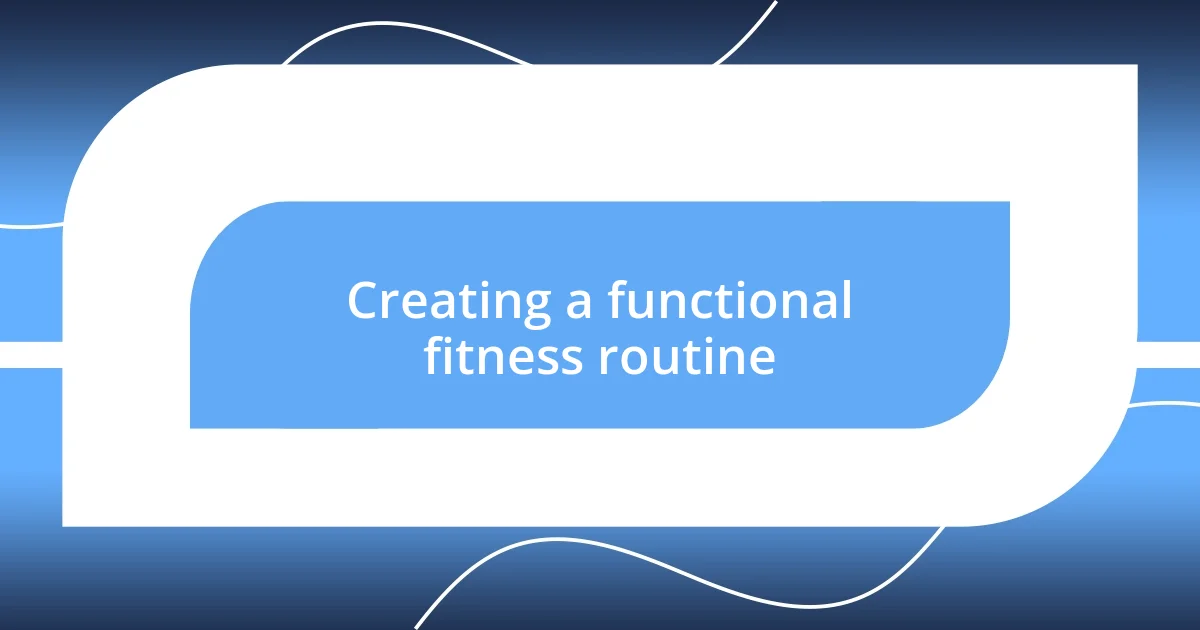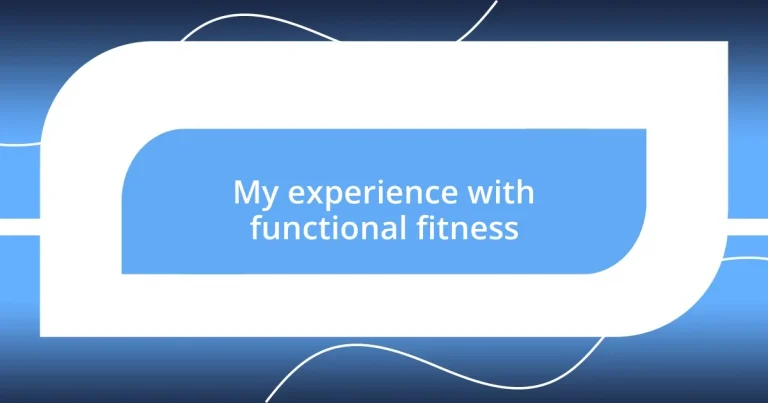Key takeaways:
- The author’s experience with functional fitness highlights its focus on enhancing real-life movements, which leads to practical strength improvements.
- Key principles include multi-joint movements, balance, core strength, real-life application, and progressive overload, which all contribute to overall physical and mental well-being.
- Social support within the community boosts motivation and fosters a sense of belonging, making the journey more rewarding and enjoyable.

My journey into functional fitness
Diving into functional fitness was a game-changer for me. I remember stepping into my first class, feeling a blend of excitement and nervousness—what would these “functional movements” entail? I quickly realized it was all about training my body for real-life activities, from lifting groceries to climbing stairs, and that relevance struck a chord with me.
One moment that stands out is when I completed my first kettlebell swing. I felt an exhilarating rush as I combined strength and coordination—something I hadn’t realized was so empowering until that day. It made me wonder: how many of us are missing out on building practical strength just because we stick to traditional workouts?
As I progressed, I began to notice improvements not just physically but also mentally. The sense of community within my functional fitness classes fostered friendships and encouraged me to push my limits. Isn’t it incredible how movement can bring us together while also transforming our everyday lives? Each class felt like a step closer to a stronger, more capable version of myself, and I became addicted to that feeling.

Understanding functional fitness principles
Understanding functional fitness principles revolves around the idea of enhancing everyday movements. The exercises mimic tasks we perform daily, which makes them both relatable and applicable. For instance, when I first learned how to properly squat, it was like a light bulb went off in my head. I realized that this simple movement prepared me not only for sitting but also for lifting my young niece with ease.
Here are some key principles of functional fitness that resonate with me:
– Multi-joint movements: Exercises like deadlifts and push-ups engage several muscle groups simultaneously.
– Balance and stability: Incorporating exercises that challenge your balance, such as single-leg deadlifts, improves overall body control.
– Core strength: A strong core is essential; it supports almost every movement, reducing the risk of injury.
– Real-life application: Functional fitness prepares your body for everyday tasks, making daily activities feel effortless.
– Progressive overload: Gradually increasing the intensity of your workouts ensures continual improvement.
These principles helped me recognize the direct impact of my training on my daily life, sparking a deeper motivation to keep going. Each workout felt like a fun puzzle to solve, translating that effort into unexpected gains in my day-to-day activities.

Key benefits of functional fitness
The key benefits of functional fitness are truly transformative. One standout benefit for me has been enhanced overall strength, which has made daily tasks so much easier. I remember shifting furniture around my apartment; lifting and moving things has become almost effortless, and I realize now that I owe that strength to the functional workouts I committed to. It’s empowering to think that I not only look stronger but also feel more capable in my everyday life.
Another area where I’ve seen significant benefits is in my agility and balance. Initially, I struggled with exercises like box jumps, often doubting my abilities. However, as I practiced these movements, I could feel my stability improving. The confidence that grew from being able to navigate uneven terrain without fear was exhilarating. This experience taught me that physical improvements can translate into mental resilience—what a powerful combination!
Lastly, I’ve found the social aspect of functional fitness to be incredibly valuable. The supportive community around me has cultivated a sense of belonging. I’m reminded of the time a fellow gym-goer cheered me on during a challenging workout. That encouragement pushed me to complete an extra set, reinforcing the idea that functional fitness is not just about personal growth; it’s about lifting each other up along the way.
| Benefits | Description |
|---|---|
| Enhanced Strength | Improved physical capabilities for daily tasks |
| Agility and Balance | Increased coordination and mental resilience |
| Community Support | A sense of belonging and motivation through shared experiences |

Effective exercises for functional fitness
One effective exercise I’ve come to love is the kettlebell swing. When I first tried it, I felt a mix of excitement and apprehension. The fluid movement engages my hips, glutes, and core, mimicking the action of picking up and carrying heavy grocery bags. I can’t overstate how quickly my endurance improved after committing to this exercise; it’s fun to see how a simple motion can replicate real-life activities so well.
Another staple in my functional fitness routine is the farmer’s carry. Picture this: I’m at the gym, gripping heavy kettlebells in each hand, strolling across the floor like I’m on a mission. Not only does this build grip strength, but it also enhances my stability, resembling the experience of walking with a couple of bags brimming with fresh produce. The next time I head to the store, I feel more confident, knowing I’ve trained my body to manage the weight.
Recently, I added step-ups to my workouts, which initially felt mundane. However, it transformed into a rewarding challenge. Every time I step onto that box, whether in the gym or at home, I realize it’s preparing me for those moments when I need to climb stairs carrying my daughter. It’s fascinating how these exercises, which initially seemed like mere workouts, have reshaped my perspective on everyday tasks, making them feel so much more achievable. Have you ever considered how these simple movements could elevate your daily life?

Creating a functional fitness routine
Creating a functional fitness routine starts with identifying your specific needs and goals. I remember when I first mapped out my plan; I considered not just wanting to look good but also wanting the ability to chase after my kids without feeling winded. This reflection helped me realize that focusing on movements I utilize daily, like squatting and lifting, was essential. Have you thought about what activities make your day challenging? Tailoring your workouts around those tasks can make a world of difference.
Once you know your goals, mixing functional exercises into your regimen becomes key. For me, pairing strength-building moves with flexibility work paid off in ways I hadn’t anticipated. Combining exercises like lunges with stretches made my workouts feel holistic and less monotonous. Could experimenting with different combinations make your routine more enjoyable? I found that a bit of creativity not only kept my workouts exciting but also helped me avoid plateaus.
Lastly, consistency is crucial in reaping the benefits. I recall weeks where my enthusiasm waned, but committing to set days for my workouts kept me on track. Recording my progress, whether in terms of weights lifted or improved endurance, added a layer of motivation. How often do you check in with yourself on your fitness journey? Creating milestones can foster that sense of accomplishment and propel you forward, ensuring that each step you take is part of a larger growth experience.

Overcoming challenges in functional fitness
When I first began my journey with functional fitness, I was faced with the challenge of self-doubt. Some exercises seemed daunting, and I often wondered if I was doing them correctly. I remember one day at the gym, feeling overwhelmed while attempting squats. A friendly trainer noticed and offered guidance. That small moment changed everything for me; it reminded me that asking for help is part of the process, not a sign of weakness. Have you ever felt hesitant to ask for assistance? Embracing support can often be the key to breaking through those mental blocks.
In another instance, I really struggled with consistency. There were weeks when life felt chaotic, and fitting in workouts seemed impossible. But here’s the thing I discovered: creating a flexible schedule helped immensely. I started setting smaller, achievable goals, like doing a quick 20-minute workout instead of an hour-long commitment. It was such a revelation! I found that even short bursts of exercise kept my momentum going. How about you? Have you considered breaking your workouts into bite-sized pieces? It can make all the difference when life gets busy.
I also encountered physical challenges that tested my perseverance. After a tough session of deadlifts, I felt intense soreness, and for a brief moment, I thought about giving up. Instead, I remembered why I started this journey: to feel capable in my everyday activities. I leaned into the discomfort, listening to my body, allowing ample recovery time, and gradually increasing my intensity. This approach not only helped me grow stronger but deepened my respect for my body’s limits. Have you faced a similar struggle? Understanding and accepting those physical boundaries can transform your mind’s perspective on fitness.














